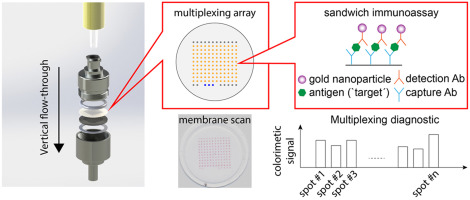Talanta ( IF 6.1 ) Pub Date : 2018-08-17 , DOI: 10.1016/j.talanta.2018.08.043 Peng Chen , Marcellene Gates-Hollingsworth , Sujata Pandit , Anson Park , Douglas Montgomery , David AuCoin , Jian Gu , Frederic Zenhausern

|
Currently, the standard method for identifying biological agents of potential threats to national security and public health, such as pathogens, virus, and toxins, mainly rely on microbiological cultivation. This method is time-consuming and it requires sophisticated equipment and well-trained personnel, which are often unavailable in remote areas or at point-of-need. Therefore, an alternative rapid, simple, and sensitive method for detecting bio-threat agents is in crucial need. We report a paper-based Vertical Flow Immunoassay (VFI) device that can overcome these limitations. The VFI device utilizes a nanoporous nitrocellulose membrane encapsulated in a stainless steel filter holder. As the sample is pushed through the membrane, which is pre-functionalized with capture antibody, a sandwich assay is formed and colorimetric signal is generated to reflect the presence of target antigens. Through theoretical analyses of antigen-antibody binding process inside a porous membrane, we identified two critical factors – membrane pore size and sample flow rate that can be optimized to improve the assay sensitivity. Then, the effects were demonstrated through experimental studies using Burkholderia pseudomallei (the causative agent of melioidosis) as a model pathogen. The B. pseudomallei VFI was based on an immunoassay targeting the B. pseudomallei surface capsular polysaccharide (CPS). The experimental results agreed well with the theory showing that increasing the flow speed (up to 1.06 mm/s) and reducing the membrane pore size (down to 0.1 µm) could improve the sensitivity by at least 5 times. The VFI's limit-of-detection for CPS spiked in buffer solution was determined to be 0.02 ng/mL. The developed VFI shows great potential as a point-of-care tool for detection of bio-threat agents in a variety of clinical and resource-restricted conditions.
中文翻译:

纸基垂直流免疫分析(VFI)用于检测生物威胁病原体
当前,识别潜在威胁国家安全和公共卫生的生物制剂(例如病原体,病毒和毒素)的标准方法主要依靠微生物培养。这种方法很耗时,并且需要复杂的设备和训练有素的人员,而这些通常在偏远地区或需要的地方是不可用的。因此,迫切需要一种替代的快速,简单和灵敏的方法来检测生物威胁因子。我们报告了一种基于纸质的垂直流免疫分析(VFI)设备,该设备可以克服这些局限性。VFI设备利用封装在不锈钢过滤器支架中的纳米多孔硝化纤维素膜。当样品被推过被捕获抗体预功能化的膜时,形成夹心测定并产生比色信号以反映靶抗原的存在。通过对多孔膜内部抗原-抗体结合过程的理论分析,我们确定了两个关键因素-膜孔径和样品流速,可以对其进行优化以提高测定灵敏度。然后,通过使用伯克霍尔德菌假疟原虫(类鼻疽病的病原体)作为模型病原体。假小芽孢杆菌VFI基于针对假小芽孢杆菌表面荚膜多糖(CPS)的免疫测定。实验结果与理论相吻合,表明增加流速(最高1.06 mm / s)和减小膜孔径(最低0.1 µm)可以使灵敏度提高至少5倍。加标在缓冲溶液中的CPS的VFI检测限为0.02 ng / mL。所开发的VFI在各种临床和资源有限的条件下,作为检测生物威胁因子的即时服务工具显示出巨大的潜力。


























 京公网安备 11010802027423号
京公网安备 11010802027423号